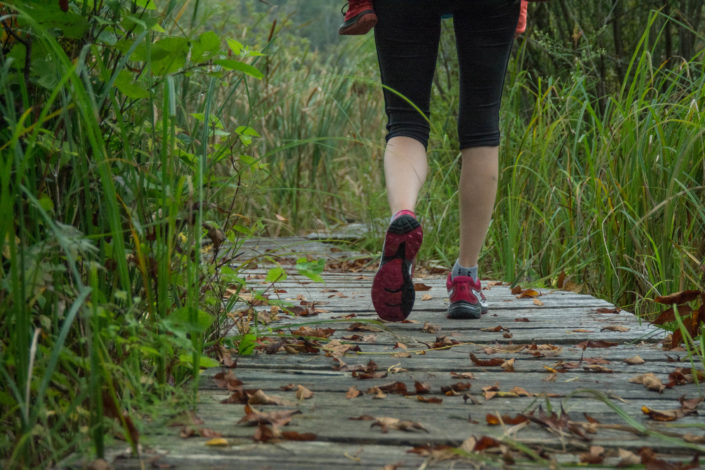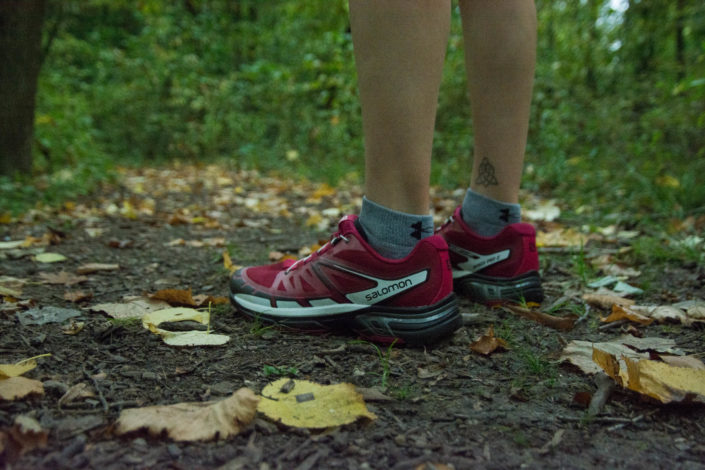Find Your Best Trail Shoe: What's Pronation Got to Do With It?
- Blog Find Your Best Trail Shoe: What's Pronation Got to Do With It?
One of the first things you learn when you start hiking is that appropriate footwear is a must. It's important to be comfortable. It's especially important to have a shoe that supports you. We know this, because chasing toddlers, carrying babies, and wrangling preschoolers all take an extra toll on your joints. The knee, ankle, and hip joints have to bear all those activities. So what exactly is pronation? And how can you find the perfect fit for your feet?
Children and adults both pronate. However, it is much less likely for a child to develop an under or over pronation. Children have more flexibility in their bones and joints. This means they're less apt to develop an injury. It's the hardening of the adult musculature that leads to issues and injuries.
When you put any extra weight on your body, the platform (the shoes) that your body rests on, becomes more important. We always think it's vital to protect your body and joints from injury. In this case it means having a shoe that provides cushion, support, control and it needs to FIT! Check out this fit guide to see if there's something you've overlooked in your shoes. Chafing can be a concern when carrying extra weight. If your shoe is too tight, your toes might be pushed toward the front of your toe box, causing blisters, ugh. If it’s too loose, chafing at the heel can occur from your foot slipping in and out of your shoe while hiking.
What is Pronation?
Quite simply pronation is the rolling of your foot as you complete a stride. It's completely normal and an important part of the shock absorption that your body does with each step. The body transfers the impact of your foot on the ground and then rolls forward and inward in order to propel you forward. Pronation is only an issue if your body does it too much (overpronation) or too little (underpronation.) This can happen due to injury, genetics, or a general weakness in your muscles and ligaments. Is this something to watch out for in kids?
Is this something to watch out for in kids?
Children and adults both pronate. However, it is much less likely for a child to develop an under or over pronation. Children have more flexibility in their bones and joints. This means they're less apt to develop an injury. It's the hardening of the adult musculature that leads to issues and injuries.
What is the best way to tell if you over or under pronate?
The simplest way, and the most effective, is to have a gait analysis done. There are quite a few stores that offer this service. Our friends at Road Runner Sports, helped me out. I walked on a treadmill that had a camera installed near my feet. They then played the video in super slow motion to track how my legs and feet were absorbing impact. They also had a pad to stand on that measured the height of my arches, to help me determine how much cushion I should be looking for in a shoe. I ended up going with the Salomon Wings Pro 2 because I have a relatively high arch and I was looking for a neutral shoe with decent cushion. I tend to pronate normally.What shoes am I looking for?
- Overpronation: you'll be trying to find a shoe that has more Stability or Motion Control. This should help prevent you from rolling over as much. It's important to correct for overpronation because it is one of the most likely causes of running related injuries including arch/foot pain, shin splints, and knee pain
- Underpronation: you'll want a shoe that is flexible enough to encourage your foot to make that roll over motion. This type of pronation is much less common than over pronation but is also highly connected to injury, especially IT band syndrome
- If you pronate normally, you'll be looking for a Neutral Shoe that offers cushion
- If you need more help deciding which shoes to buy, check out this neat tool.
 I'm carrying a baby/toddler/preschooler....
I'm carrying a baby/toddler/preschooler....
When you put any extra weight on your body, the platform (the shoes) that your body rests on, becomes more important. We always think it's vital to protect your body and joints from injury. In this case it means having a shoe that provides cushion, support, control and it needs to FIT! Check out this fit guide to see if there's something you've overlooked in your shoes. Chafing can be a concern when carrying extra weight. If your shoe is too tight, your toes might be pushed toward the front of your toe box, causing blisters, ugh. If it’s too loose, chafing at the heel can occur from your foot slipping in and out of your shoe while hiking.
Hiking Boot vs Running Shoe vs Trail Runner
The main difference between a street running shoe and a trail running shoe is the massive amount of tread on the trail runner. This provides much needed traction and grip. The tread will keep you from slipping and sliding while traversing technical uphill climbs or even tamer hikes that feature loose or slick dirt. And we all know that the dirt can easily fly with a toddler around. Avoiding slipping means you're avoiding added tension and stress on your joints. The result? Less injuries. Trail shoes also tend to be made of more durable and thicker materials. They tend to be a bit heavier than an urban runner because they need to stand up to rocks, roots, and more aggressive ascents and descents. Boots tend to have higher ankle support and a less flexible sole. Whatever shoe model you choose to step out in, make sure it fits. Don't buy a size smaller just because they're on sale. (Ask me how I know!) Just remember your feet are completely unique. Just because something worked for your friend, doesn’t mean it’ll work for you. The best way to tell what’s best for you is to have a thorough analysis and fitting done (find a Road Runner Sports location near you). The nice thing about that is once you find a shoe you love and fits well, there doesn't have to be agony every time your shoe wears out. Just buy the next year's model, at least until the company discontinues it.Photos Courtesy of Jessica Featherstone
This post is sponsored by Road Runner Sports. Hike it Baby received compensation in exchange for writing this review. All opinions are our own. Road Runner is generously offering a discount to our Hike it Baby Readers. All our community specific discounts can be found on this page. Tell us your favorite trail shoe below!Related Content




Comments